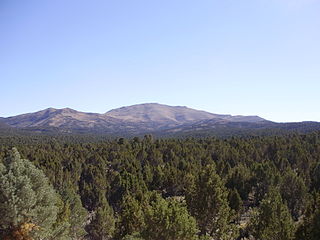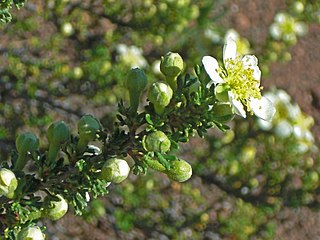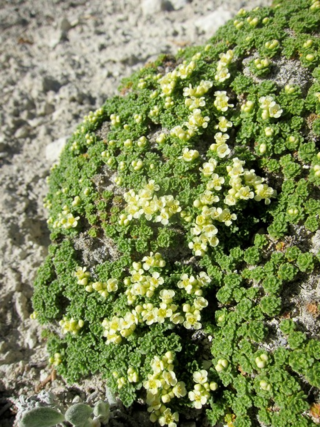
Purshia is a small genus of 5–8 species of flowering plants in the family Rosaceae which are native to western North America.

Purshia tridentata, with the common name bitterbrush, is a shrub in the genus Purshia of the family Rosaceae. It is native to mountainous areas of western North America.

Allium validum is a species of flowering plant commonly called swamp onion, wild onion, Pacific onion, or Pacific mountain onion. It is native to the Cascade Range, to the Sierra Nevada, the Rocky Mountains, and other high-elevation regions in California, Oregon, Washington, Nevada, Idaho and British Columbia. It is a perennial herb and grows in swampy meadows at medium and high elevations.

Allium acuminatum, also known as the tapertip onion or Hooker's onion, is a species in the genus Allium native to North America.

Peucephyllum is a monotypic genus of flowering plants containing the single species Peucephyllum schottii. Its common names include pygmy cedar, Schott's pygmy cedar, desert fir, and desert pine. It is not a cedar, fir, or pine, but a member of the aster family, Asteraceae. It is a leafy evergreen shrub with glandular, resinous foliage. It flowers in yellow flower heads which have only disc florets. The fruits are woody, bristly seeds with a pappus. This plant is native to the deserts of Arizona, California, Nevada, and Utah in the United States and Baja California and Sonora in northern Mexico.

Wislizenia refracta, common names jackass clover or spectacle fruit, is one of the three recognized species in its genus Wislizenia, which some authors consider subspecies. It is native to northwestern Mexico and the southwestern United States, particularly Chihuahua, Sonora, trans-Pecos Texas, New Mexico, Arizona, Utah, Nevada and California. The species occurs in sandy flats, desert scrub and disturbed sites such as roadsides.

Allium atrorubens is a species of wild onion known by the common name dark red onion. This plant is native to the southwestern United States where it grows in the sandy soils of the Mojave Desert, the Great Basin and higher-elevation deserts in Nevada, eastern California southwestern Utah, northwestern Arizona.

Galium multiflorum is a species of flowering plant in the coffee family known by the common names Kellogg's bedstraw, shrubby bedstraw, and many-flowered bedstraw. It is a perennial herb that grows on rocky soils, mountains, and desert slopes.

Goodyera oblongifolia is a species of orchid known by the common names western rattlesnake plantain and giant rattlesnake plantain. It is native to much of North America, particularly in the mountains of the western United States and Canada, from Alaska to northern Mexico, as well as in the Great Lakes region, Maine, Quebec and the Canadian Maritime Provinces.
Allium punctum is a species of wild onion known by the common name dotted onion or Modoc onion. It is native to the western United States in and around the Modoc Plateau in northeastern California, northwestern Nevada, and southeastern Oregon. It is uncommon, growing in volcanic flatlands created by old lava flows.

Menodora spinescens is a species of flowering plant in the olive family known by the common name spiny menodora. It is native to the southwestern United States, where it grows in varied mountain, canyon, and desert habitat in California, Nevada, Utah and Arizona.

Pinyon–juniper woodland, also spelled piñon–juniper woodland, is a biome found mid-elevations in arid regions of the Western United States, characterized by being an open forest dominated by low, bushy, evergreen junipers, pinyon pines, and their associates which vary from region to region. At lower elevations, junipers often predominate and trees are spaced widely, bordering on and mingling with grassland or shrubland, but as elevation increases, pinyon pines become common and trees grow closer, forming denser canopies. Historically, pinyon-juniper woodland has provided a vital source of fuel and food for peoples of the American Southwest. These nuts have also provided a crucial source of food for species such as the Pinyon jay, which have become threatened as landowners have historically tried to convert large areas of pinyon-juniper woodland to grazing lands.

Purshia mexicana is a species of perennial flowering small tree in the rose family known by the common name Mexican cliffrose. It is native to western-northern Mexico, the region of the Sierra Madre Occidental cordillera.

Purshia glandulosa is a species of flowering plant in the rose family known by the common names antelope bitterbrush, desert bitterbrush, Mojave antelope brush, and cliff-rose.
Chrysothamnus molestus is a species of flowering plant in the family Asteraceae known by the common names Arizona rabbitbrush, Tusayan rabbitbrush, disturbed rabbitbrush, and stickyfruit low rabbitbrush. It is endemic to the State of Arizona in the southwestern United States, where it is known from Coconino, Apache, and Navajo Counties.
Callophrys fotis is a species of butterfly in the family Lycaenidae, the gossamer-winged butterflies. It is known by several common names, including early elfin, desert elfin, Fotis hairstreak, Strecker's elfin, and Arizona gray elfin. It is native to the southwestern United States, where it occurs in southeastern California, Nevada, Utah, western Colorado, northern Arizona, and northwestern New Mexico.
Wyethia arizonica, the Arizona mule's ears, is a plant species native to Arizona, Colorado, New Mexico and Utah. It grows in meadows in coniferous forests at elevations of 600–3,000 m (2,000–9,800 ft).
Descurainia paradisa is a plant species native to eastern and northern California, southeastern Oregon, Box Elder County in northwestern Utah, and most of Nevada. It grows in shrub communities at elevations of 3,300–7,500 feet (1,000–2,300 m).

Lepidium nanum, the dwarf pepperweed, is a plant species native to the US states of Nevada and Utah. It is known from four counties in Nevada but only one in Utah. It occurs in open, sunlit areas in the desert, often with gypsum, limestone, quartzite or chalky soils.

Erigeron poliospermus is a species of flowering plant in the family Asteraceae known by the common names gray-seeded fleabane, purple cushion fleabane, and hairy-seed fleabane. Native to western North America, it is mainly found to the east of the Cascade Range in Washington, Oregon, and Idaho.















